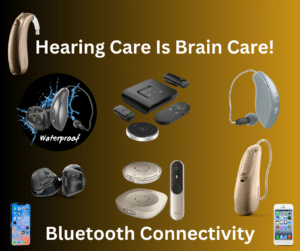Exploring the Advanced Features of Modern Hearing Aids
Modern hearing aids have undergone a significant evolution. Gone are the days when hearing aids were merely amplifiers. Hearing loss can significantly impact one’s quality of life, making it difficult to engage in conversations, enjoy music, or participate in social activities. Today’s advanced technology has revolutionized the capabilities of hearing aids, offering a range of features designed to address various challenges faced by individuals with hearing impairments. From noise reduction to Bluetooth connectivity, these features are revolutionizing the way people interact with their environment and communicate with others. Common features of modern hearing aids include noise reduction, directional microphones, Bluetooth connectivity, rechargeability, and now the ability to pair with smartphones like iPhones and Android devices.
Advanced Features such as:
Noise Reduction: Noise reduction technology is a game-changer for individuals with hearing loss, as it helps to filter out background noise, allowing users to focus on speech sounds. This feature utilizes sophisticated algorithms to distinguish between speech and non-speech sounds, thereby improving speech clarity in noisy environments such as restaurants or crowded gatherings. Noise reduction helps mitigate the effects of background noise, making speech more intelligible.
Directional Microphones: Directional microphones are designed to pick up sounds coming from specific directions while minimizing background noise from other directions. By focusing on the speaker in front of the user, directional microphones improve speech intelligibility, especially in situations where there is competing noise from different directions. Directional microphones enhance speech clarity by focusing on the desired sound source.
Bluetooth Connectivity: Bluetooth connectivity enables seamless integration of hearing aids with various electronic devices such as smartphones, tablets, and televisions. This feature allows users to stream audio directly to their hearing aids, enhancing their listening experience while watching movies, making phone calls, or listening to music. Additionally, Bluetooth connectivity enables users to control their hearing aids remotely via dedicated smartphone apps, providing greater convenience and customization. Bluetooth connectivity improves accessibility and connectivity, enabling users to stay connected with the world around them.
Rechargeability: Rechargeable hearing aids eliminate the hassle of constantly replacing disposable batteries. With rechargeable batteries, users can simply place their hearing aids on a charging dock overnight, ensuring they have a full day of usage without worrying about running out of power. This feature not only simplifies maintenance but also reduces environmental waste associated with disposable batteries. Rechargeability eliminates the inconvenience and cost associated with traditional disposable batteries, promoting consistent usage.
Modern hearing aids offer customizable settings and programmability to cater to the unique needs and preferences of each user. Audiologists can fine-tune various parameters such as volume, frequency response, and microphone sensitivity to optimize the user’s listening experience. Additionally, many hearing aids feature automatic adaptive technology that adjusts settings in real-time based on the user’s environment, ensuring optimal performance in different listening situations. The integration of advanced features in modern hearing aids has significantly enhanced the user experience and improved overall satisfaction. Users report greater comfort, clarity, and convenience compared to traditional analog devices. With the ability to customize settings, connect wirelessly to electronic devices, and enjoy all-day rechargeable power, individuals with hearing loss can now engage more fully in social interactions, work environments, and recreational activities.
Modern hearing aids represent a remarkable fusion of cutting-edge technology and user-centric design. By addressing specific challenges, offering customizable settings, and enhancing user satisfaction, modern hearing aids are empowering individuals to embrace clarity and reconnect with the sounds of life.